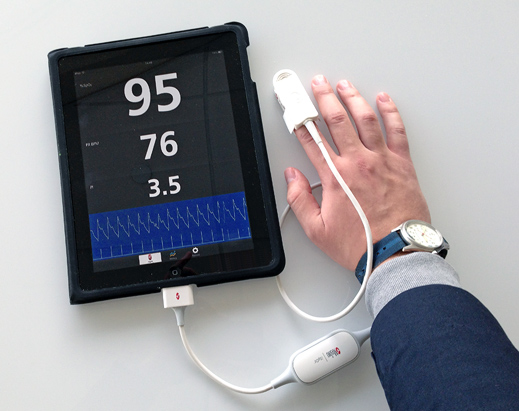A Glut of Gadgets Track Your Body’s Vital Signs
A parade of fitness gadgets at this week’s Consumer Electronics Show in Las Vegas may be just the antidote for the couch-potato behavior induced by all the 3-D televisions, gaming laptops, and other gizmos on display at the show.

Some of these activity-monitoring devices offer new ways to monitor your activity and health, including an iPhone and iPad pulse oximeter that can precisely detect blood oxygen levels, and sensor technology that can be tucked inside a set of conventional earbuds to keep tabs on the whole body.
Health experts hope that such technology could encourage healthier habits. And although it is not always easy to get people to pay attention to or act on the collected data, the medical device industry clearly senses an opportunity.
One example is the iSpO2, a pulse oximeter from Masimo, an Irvine, California company. The iSpO2 clips onto a finger and measures the amount of oxygen carried in blood. The device shines both infrared and red light into the digit; blood absorbs different amounts of each frequency depending on how much oxygen is carried by red blood cells. Masimo already makes pulse oximeters for medical settings, but its new product is targeted at consumers.
Pilots who fly unpressurized aircraft and hikers who climb to high altitudes could benefit from the iSpO2, says Brandon Strand, marketing project manager for iSpO2. Such adventurers need to be on guard for hypoxia, a condition in which the blood carries too little oxygen. “One of the problems in hypoxia is that you don’t know that you are being subjected to it. It has been compared to being drunk,” says Strand. “A product like this will allow you to know more.”
The consumer pulse oximeter could also help serious athletes, suggests Dana Banks, head of communications at Masimo. “When you work out, your oxygen saturation can decrease by 20 to 50 percent,” she says. “Athletes who are really into pushing their performance can use their oxygen saturation to help them understand their workout—when to push through, and when they’ve reached their peak.”
Someone using Masimo’s device downloads a free app from the Apple App Store, plugs the pulse oximeter into his or her device, and clips the gadget onto a finger. But the finger sensor is relatively large—a two-inch-long plastic case—and is tethered by a two-foot-long cord to a device, which could make it cumbersome during aerobics exercises that involve a lot of twisting or arm movement.
Other devices at CES include MisFit Wearable’s Shine and Fitbit’s new Flex, both wireless, watch-like activity-tracking devices. Meanwhile, Dallas-based Hothead Technologies will debut its new product, Spree, a headband with sensors to measure heart rate, body temperature, and motion that can work with or without a smartphone, says company president Peter Linke. Hothead Technologies sells overheating warning systems for industry and sports (say, for construction workers or high school football teams). The Spree could likewise warn exercisers when they are getting too hot, says Linke.
Raleigh-based Valencell makes small sensor technology called PerformTek that can fit into earbuds or other small electronics. A Valencell-enabled device can measure heart rate, respiration rate, speed, distance, and VO2max, which is a measure of oxygen consumption. On Tuesday, Valencell announced that the first product to use its sensor technology will be manufactured by South Korean consumer electronics company iriver.
Another recent entry into the tracking world is Basis. The company’s wristwatch measures heart rate, perspiration, temperature, and motion. Basis is designed to be worn 24/7, so that sleep as well as movement associated with daily life is tracked. “Our perspective is, how do we help the vast millions find health in their everyday life,” says CEO Jef Holove.
His company’s product was announced in late November, but at CES, Basis will present an app that tracks and analyzes user data with the goal of helping people develop health habits and “find little movements of health in everyday life,” says Holove.
“The wide availability of trackers that connect to smartphones is changing fitness by encouraging ‘wear, share, compare’ tracking,” says Carol Torgan, an exercise physiologist and fellow of the American College of Sports Medicine. These devices “make it easy for people to upload their data and share it with friends, to compete, to brag, to set goals, and to be accountable.”
Valencell’s CEO Steven LeBoeuf says the move to other parts of life will happen gradually, but seamlessly. “The things we measure have been correlated with health. Eventually people are going to appreciate how you can use this to tailor health plans for people, essentially personalized directed health care.”
Keep Reading
Most Popular
Large language models can do jaw-dropping things. But nobody knows exactly why.
And that's a problem. Figuring it out is one of the biggest scientific puzzles of our time and a crucial step towards controlling more powerful future models.
The problem with plug-in hybrids? Their drivers.
Plug-in hybrids are often sold as a transition to EVs, but new data from Europe shows we’re still underestimating the emissions they produce.
Google DeepMind’s new generative model makes Super Mario–like games from scratch
Genie learns how to control games by watching hours and hours of video. It could help train next-gen robots too.
How scientists traced a mysterious covid case back to six toilets
When wastewater surveillance turns into a hunt for a single infected individual, the ethics get tricky.
Stay connected
Get the latest updates from
MIT Technology Review
Discover special offers, top stories, upcoming events, and more.